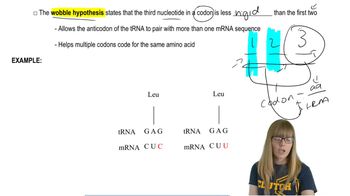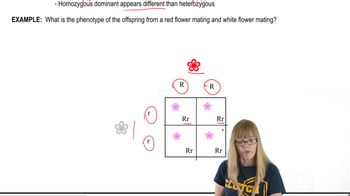Table of contents
- 1. Introduction to Genetics51m
- 2. Mendel's Laws of Inheritance3h 37m
- 3. Extensions to Mendelian Inheritance2h 41m
- 4. Genetic Mapping and Linkage2h 28m
- 5. Genetics of Bacteria and Viruses1h 21m
- 6. Chromosomal Variation1h 48m
- 7. DNA and Chromosome Structure56m
- 8. DNA Replication1h 10m
- 9. Mitosis and Meiosis1h 34m
- 10. Transcription1h 0m
- 11. Translation58m
- 12. Gene Regulation in Prokaryotes1h 19m
- 13. Gene Regulation in Eukaryotes44m
- 14. Genetic Control of Development44m
- 15. Genomes and Genomics1h 50m
- 16. Transposable Elements47m
- 17. Mutation, Repair, and Recombination1h 6m
- 18. Molecular Genetic Tools19m
- 19. Cancer Genetics29m
- 20. Quantitative Genetics1h 26m
- 21. Population Genetics50m
- 22. Evolutionary Genetics29m
17. Mutation, Repair, and Recombination
Types of Mutations
Problem 3a
Textbook Question
Textbook QuestionFor the retinal cancer retinoblastoma, the inheritance of one mutated copy of RB1 from one of the parents is often referred to as a mutation that produces a 'dominant predisposition to cancer.' This means that the first mutation does not produce cancer but makes it very likely that cancer will develop.
Explain why cancer is almost certain to develop with the inheritance of one mutated copy of RB1.
 Verified Solution
Verified SolutionThis video solution was recommended by our tutors as helpful for the problem above
Video duration:
2mPlay a video:
Was this helpful?
Key Concepts
Here are the essential concepts you must grasp in order to answer the question correctly.
Tumor Suppressor Genes
Tumor suppressor genes, such as RB1, are crucial for regulating cell growth and preventing uncontrolled cell division. When one copy of a tumor suppressor gene is mutated, the remaining normal copy can often compensate. However, in the case of retinoblastoma, inheriting one mutated RB1 gene significantly increases the risk of a second mutation occurring in the remaining normal copy, leading to cancer development.
Recommended video:
Guided course

Mapping Genes
Two-Hit Hypothesis
The two-hit hypothesis explains how cancer can develop in individuals with a hereditary predisposition. According to this model, the first 'hit' is the inherited mutation of one RB1 allele, which predisposes the individual to cancer. The second 'hit' occurs when the remaining normal allele is mutated, resulting in the loss of function of both alleles, which is necessary for tumor formation.
Recommended video:
Guided course

Translation:Wobble Hypothesis
Dominant Inheritance
Dominant inheritance refers to the pattern where only one mutated copy of a gene is sufficient to increase the risk of a trait or disease. In the case of retinoblastoma, inheriting one mutated RB1 gene from a parent leads to a dominant predisposition to cancer, meaning that individuals are at a significantly higher risk of developing the disease, even if they do not exhibit symptoms initially.
Recommended video:
Guided course

Variations on Dominance

 9:49m
9:49mWatch next
Master Point Mutations with a bite sized video explanation from Kylia Goodner
Start learning



